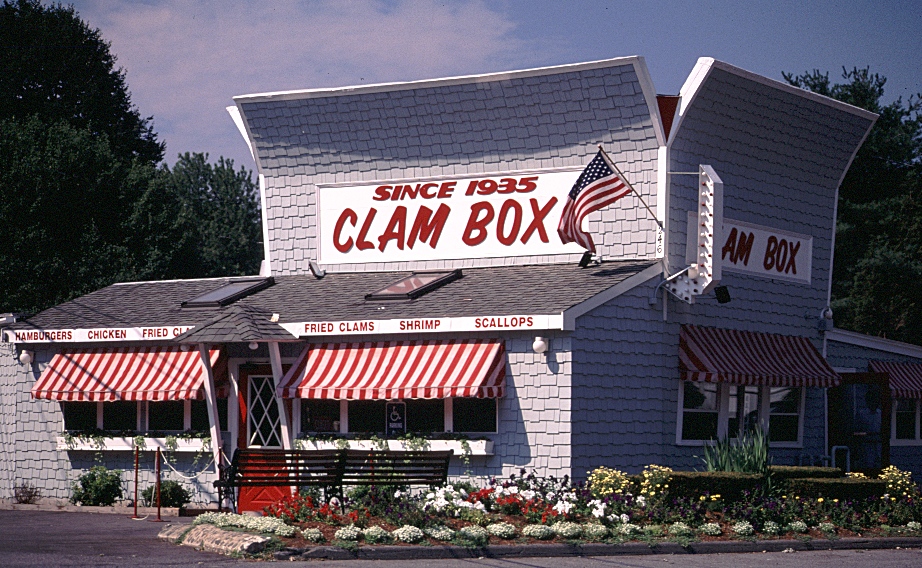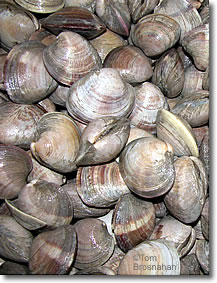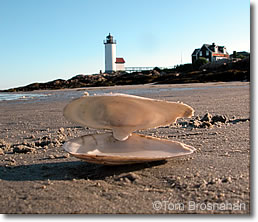How to Eat New England Clams
Eating "steamers" (steamed clams) along with lobster is one coastal New Englanders' favorite summer culinary treats.
About Steamed Clams
In New England, a steamer is a soft-shelled clam (Mya arenaria), called soft-shelled because its calcium shell is less hard and more chalky than the alabaster-like shells of hard-shell clams (Mercenaria mercenaria).
Ordering Steamers
Steamers are sold by weight (a half-pound, a pound, two pounds, etc.), and served in a small bucket (into which you can throw the empty shells after your meal). You'll also get a bowl of "clam broth" (seawater that has had clams steamed in it—even in a restaurant you'll be provided with it) and a bowl of melted butter.

Ipswich MA is known for its clams. This restaurant is shaped like a traditional fried-clam box.
How to Eat a Steamer
Take a clam from the bucket, open it completely, and lift out the meat with your fingers. The "neck" is black and covered with a disgusting wrinkled black membrane. Shuck the membrane off by holding the clam in one hand and slipping the membrane with the other (you pick up the knack for this by about the fifth clam).
Holding the clam by its black "neck," dip it several times in the clam broth. The "broth" is strictly for dipping, by the way, not for sipping. The dipping washes sand off the clam and imparts the tang of the sea.
Dip the clam in the melted butter and pop the whole thing in your mouth.
Repeat!
Hard-shell Clams
Hard-shell clams, by the way, are unrelated to soft-shell clams. Hard-shell clams, or quahogs (KO-hogs) are all of the same genus (Mercenaria mercenaria), but are called by different names depending on their size:
- Littlenecks = small
- Topnecks = medium
- Cherrystones = larger
- Quahogs = largest

Hard-shell clams.
The smaller sizes are often eaten raw on the half-shell with a spritz of lemon or a dab of horseradish. Fist-sized quahogs are usually cut into strips to become fried clams, or pieces to be cooked with potatoes, milk and cream in New England clam chowder.
When you've had your fill of clams, it's on to the next course in your authentic old-time New England Clambake: buttered ears of corn, and finally to the lobsters. Eating a lobster is an art in itself.
A New England Clambake
Whether on the beach around a driftwood fire, at a backyard cookout or in a restaurant, you may be lucky enough to encounter a traditional clambake during your stay in New England.
The true traditional clambake takes place on the beach, starting with the digging of the clams, but the backyard and restaurant versions are good substitutes provided you observe the rituals properly.
The three essential courses are:
Here's a clambake recipe:
- Fill a huge pot or kettle with clean seawater and place on the fire to boil.
- Put live lobsters in the bottom, then a layer of seaweed, then ears of corn, more seaweed, and finally a layer of "steamers" (soft-shell clams for steaming).
- When the clamshells open, the steamed clams are ready to eat. After you've had a dozen or so clams, move on to corn-on-the-cob with butter and salt.
- Finally, haul out the lobsters, bright red by now, and eat them mostly with your hands.
- Clean yourself up by taking a swim in the surf!
It's impractical for most people to have a real New England beach clambake, but you can do it pretty well in any New England seafood restaurant.
Order the New England clambake and you'll get steamers, corn-on-the-cob, and at least one lobster. Enjoy!

